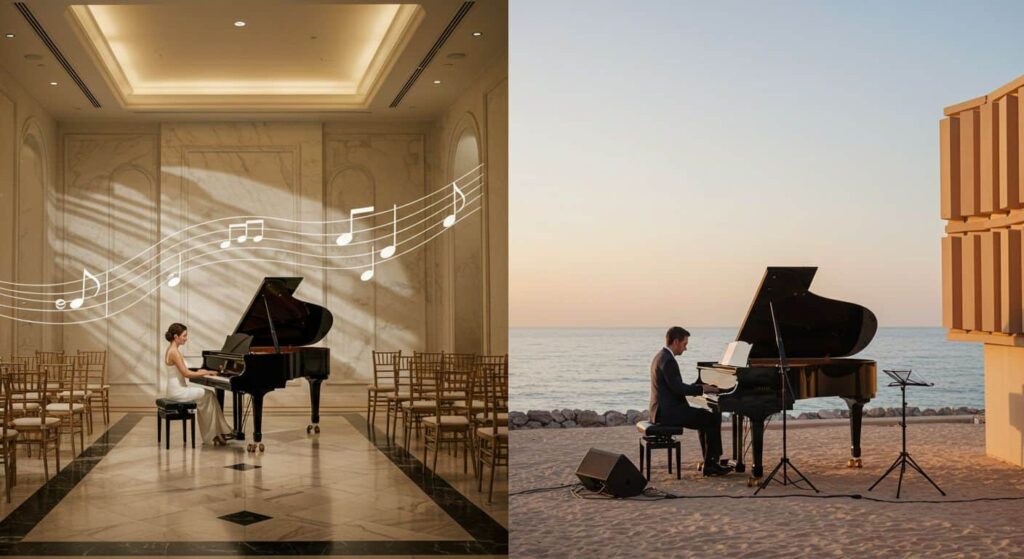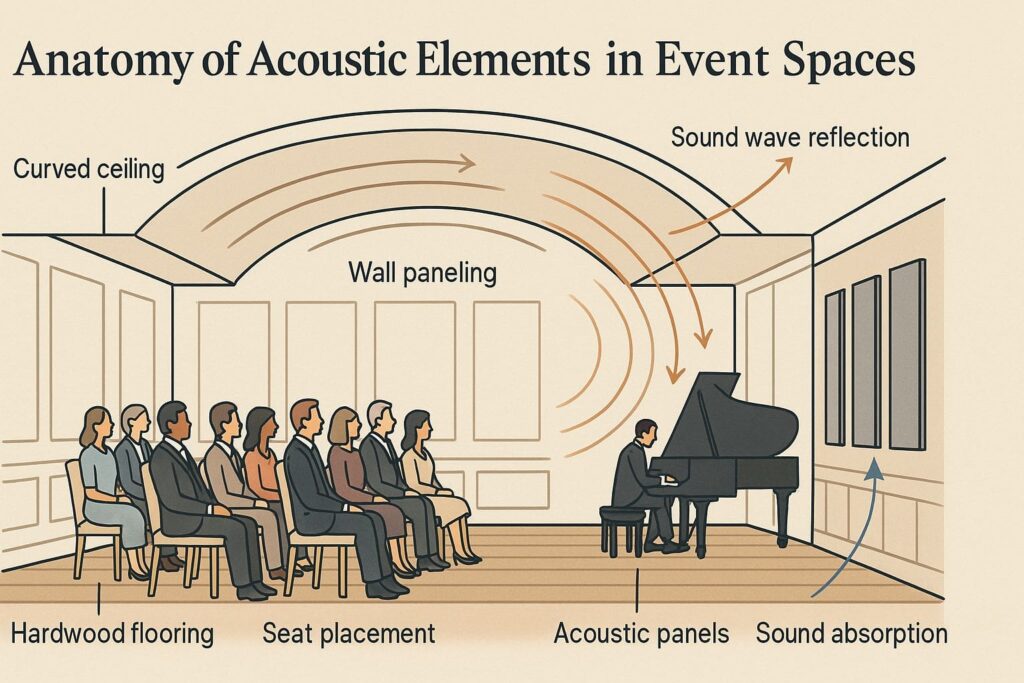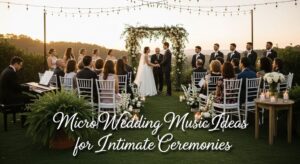Piano performances sound different in every venue due to the room’s design and materials. As a professional pianist with over 20 years of experience performing across New Jersey, New York City, and Philadelphia, I’ve encountered countless venue acoustics that directly impact how musicians control their dynamics, timing, and expression during a performance.
When you book Arnie Abrams Entertainment for your special event, you’re not just getting a pianist – you’re getting an expert who understands how to adapt to your venue’s unique acoustic properties to deliver the perfect sound experience for your guests.
Key Takeaways
- Reverberation time (1.8-2.2 seconds for classical piano) determines how long sound lingers in a space, with room size directly affecting this property – a factor I consider when performing at weddings and corporate events.
- Hard surfaces like marble and glass reflect sound waves, while soft materials like curtains and carpets absorb them, creating the acoustic balance needed for piano performances – something I’ve mastered through years of playing in diverse event venues.
- Room shape affects sound distribution—rectangular “shoebox” designs and fan-shaped layouts spread piano notes more evenly than square rooms, which create standing waves that I adapt to when performing at your private parties.
- Ceiling height dramatically impacts piano acoustics, with concert halls often featuring ceilings at least 40 feet high to create optimal resonance and sound travel – an element I account for when arranging my setup.
- Seat placement changes how guests experience piano music, with the acoustic “sweet spot” typically located in the center section, about one-third back from the stage – insights I use when consulting on event planning.
Key Acoustic Factors in Venue Design
The design of a venue shapes every note a pianist plays through specific acoustic elements. These elements control how sound travels, bounces, and reaches the audience’s ears during a performance – crucial knowledge I bring to every wedding ceremony, cocktail hour, or holiday party.
Reverberation Time
Reverberation time measures how long sound lingers in a space after the source stops playing. For luxury events featuring piano performances, this factor can make or break the musical experience.
Perfect reverberation allows piano notes to blend without muddying the sound. Most concert halls aim for 1.8 to 2.2 seconds of reverberation time for classical piano music. Room size greatly impacts this acoustic property—larger spaces naturally create longer reverberations.
As an experienced professional pianist, I’ve learned to adjust my playing style to complement each venue’s unique acoustic signature. When performing at your Bar/Bat Mitzvah or anniversary celebration, I carefully consider the room’s acoustic properties to deliver the perfect musical atmosphere.
Sound waves bounce off walls, ceilings, and floors, creating reflections that enhance the piano’s richness. Too much reverberation causes notes to blur together, while too little makes the piano sound flat and lifeless. When you hire Arnie Abrams Entertainment, you get a pianist who knows how to adapt to each acoustic environment, changing dynamics and tempo to match the space perfectly.
Sound Reflection and Absorption
Sound waves bounce off hard surfaces like marble, glass, and concrete, creating reflections that enhance piano notes in performance spaces. These reflective materials send sound directly to guests’ ears, making the piano sound fuller and more expressive.
Luxury event venues with the right balance of reflective surfaces allow piano performances to reach every corner of the room with clarity. Too much reflection, though, causes echoes that muddy the musical experience for your guests.
The perfect acoustic environment balances reflection and absorption like a master chef balances flavors – something I’ve perfected through my 20+ years of musical experience across New Jersey, North Jersey, Central Jersey, South Jersey, NYC, and Philadelphia.
Acoustic panels and soft materials like curtains, carpets, and upholstered furniture absorb excess sound waves that might otherwise create unwanted echoes. Strategic placement of these absorptive elements helps control reverberation time—the period sound lingers in a space after the source stops.
For milestone celebrations featuring piano performances, this balance creates an intimate acoustic environment where every note reaches guests with warmth and clarity. The shape of your venue also plays a crucial role in how sound travels throughout the space – a consideration I discuss with clients during my free consultation for wedding music and other special events.
Diffusion and Clarity
Sound diffusion creates a balanced acoustic environment where piano notes spread evenly throughout the venue. For luxury events, diffusion prevents harsh echoes that can ruin a performance.
Concert halls use special wall treatments with irregular grooving to scatter high frequencies and reduce what experts call “acoustical glare.” This technique transforms flat surfaces into acoustic assets that enhance the piano’s rich tones.
When performing at your wedding ceremony, cocktail hour, or Christmas party, I pay close attention to the venue’s acoustic properties to ensure proper diffusion allows your guests to enjoy clear musical details from any seat.
Clarity in acoustics refers to how distinct each piano note sounds to listeners. The architectural design directly impacts this clarity. Room shapes with strategic angles help direct sound waves toward the audience without muddling the performance – something I’ve learned to navigate expertly when playing at various event venues throughout the region.
This balance creates the perfect acoustic foundation for milestone celebrations where every musical detail matters – which is why so many clients rely on Arnie Abrams Entertainment for their most important events.
How Venue Shape Influences Piano Acoustics

The shape of a concert hall directly impacts how piano notes travel through space. Room geometry creates distinct sound patterns that pianists must adapt to during performances – knowledge I’ve gained through countless performances at weddings, religious ceremonies, and corporate events.
Geometric Layout of the Room
Room shape directly impacts how piano sounds travel to listeners’ ears. Square rooms often create standing waves that cause uneven sound distribution, while rectangular spaces provide better sound flow.
As an experienced professional pianist, I’ve performed in countless venues and learned to adapt my playing style to each unique space. For outdoor weddings at the Jersey Shore and indoor corporate events, I position my piano strategically to work with the room’s natural acoustics.
Acoustic engineers know that fan-shaped layouts spread sound waves more evenly across the audience. When consulting on event planning, I often recommend venues with proven acoustics, like those with the “shoebox” design—a rectangular shape with high ceilings that creates rich reverberation for piano performances.
The architectural design of a music venue plays a significant role in shaping its acoustic performance, affecting how guests experience every note of a piano performance – something I consider carefully when performing at same-sex weddings and other special celebrations.
Piano placement matters too—positioning the instrument where sound can reflect off nearby surfaces will enhance its projection. With my expertise as both a pianist and keyboard player, I ensure optimal placement for the best possible acoustic experience.
Ceiling Height and Angles
How Ceiling Height Affects Piano Sound Quality
Low Ceiling (8-10 feet)
- Quick reflection of sound waves
- Limited resonance development
- Sound can seem compressed
- May require less pedal use
Medium Ceiling (15-25 feet)
- Optimal balance for most events
- Allows sound to develop properly
- Clear without excessive reverberation
- Works well for diverse repertoire
High Ceiling (30-40+ feet)
- Longer reverberation times
- Fuller, more resonant piano tones
- Ideal for classical and romantic pieces
- Creates dramatic acoustic atmosphere
Beyond the basic layout of a room, ceiling height plays a major role in piano acoustics. High ceilings allow sound waves to travel farther before reflecting back, creating a fuller, more resonant sound that enhances piano performances.
Concert halls often feature ceilings of at least 40 feet to create optimal reverberation times. The angles of these ceilings matter too. Sloped or vaulted ceilings direct sound waves toward the audience rather than letting them dissipate upward.
In my 20+ years of experience performing at weddings, Bar/Bat Mitzvahs, and senior centers, I’ve learned how to leverage ceiling architecture to create the perfect acoustic environment for each unique occasion.
Many luxury venues now incorporate acoustic shells with angled panels that redirect piano notes evenly across the room. These architectural features ensure guests at your high-end events enjoy consistent sound quality regardless of their seating position. My experience performing in diverse venues throughout NJ, NYC, and Philadelphia has taught me how to work with these architectural elements to transform a standard performance into an immersive musical experience that elevates your entire event.
Use of Curved Surfaces
While ceiling height affects sound distribution, curved surfaces play a crucial role in directing sound waves throughout your event space. Curved walls and ceilings create focal points that reflect piano notes toward specific areas of the room.
Concert halls like the Sydney Opera House use curved designs to spread sound evenly across the audience. These surfaces prevent “dead spots” where music might sound flat or distant to guests.
With my versatile repertoire spanning multiple genres, I’ve performed in countless venues with varying acoustic designs. Whether playing classical pieces for your wedding ceremony or jazz standards during cocktail hour, I understand how curved acoustic shells act as reflective surfaces that redirect sound toward your guests.
For milestone events, strategic placement of curved panels can enhance the piano acoustics without disrupting your visual design. As a professional pianist who has performed at countless events, I’ve learned to identify and utilize these architectural features to make my music feel fuller and more expressive.
Materials and Their Impact on Acoustics
Materials shape the sound of every piano note through their ability to absorb, reflect, or diffuse sound waves. As a professional pianist with extensive experience performing at weddings, cocktail parties, and corporate events across the tri-state area, I’ve learned how wood, concrete, glass, and fabric create different acoustic environments.
How Different Materials Affect Piano Acoustics
Reflective Materials
- Marble: Creates bright, clear reflections, enhancing piano projection
- Glass: Produces sharp reflections, increases brilliance of high notes
- Concrete: Provides solid sound reflection, creates full-bodied resonance
- Hardwood: Offers warm, natural reflections, enhancing piano tone quality
Absorptive Materials
- Carpeting: Absorbs high frequencies, reduces brilliance and projection
- Curtains: Softens sound reflections, creates more intimate acoustic
- Upholstered Furniture: Absorbs mid-range frequencies, reduces room resonance
- Acoustic Panels: Strategically controls sound reflection and absorption
Diffusive Materials
- Wood Paneling: Scatters sound waves, creates natural sound diffusion
- Irregular Wall Surfaces: Breaks up sound reflections, reduces acoustic glare
- Bookcases: Creates complex diffusion patterns, enhances sound quality
- Coffered Ceilings: Distributes sound waves evenly throughout space
Best Combinations for Events
- Wedding Ceremonies: Hardwood floors + strategic curtains
- Cocktail Hours: Wood paneling + moderate soft furnishings
- Formal Receptions: Hardwood + acoustic panels on walls
- Outdoor Events: Portable acoustic shells + strategic tent placement
Flooring and Wall Materials
Hardwood floors create warm, rich tones that enhance piano performances, while stone or marble surfaces produce brighter, more resonant sounds. As a professional pianist serving New Jersey, NYC, and Philadelphia, I’ve performed in countless venues and can help you select the perfect space for your event’s musical ambiance.
Carpet absorbs high frequencies and dampens sound projection, making it less ideal for musical performances that require clarity. Wall materials equally impact sound quality – wood paneling offers natural diffusion and warmth, while glass or concrete creates strong reflections that can either enrich or overwhelm piano notes depending on the room size.
With my expertise gained from performing at numerous weddings, Bar/Bat Mitzvahs, and holiday parties, I can advise you on how your venue’s materials will affect the musical experience. During my free consultation, we can discuss how to optimize the acoustic environment for your specific event.
Room acoustic feedback directly influences the dynamics and timbre of piano music, making material selection crucial for milestone events featuring musical performances. The perfect balance of reflective and absorptive surfaces creates an acoustic environment where piano notes feel fuller and more expressive, elevating the guest experience at high-end gatherings – something I strive to achieve at every performance.
Acoustic Panels and Treatments
Acoustic panels serve as vital tools for luxury event planners seeking perfect sound environments. These specialized materials absorb excess sound waves that bounce off hard surfaces, reducing reverberation time and creating clearer piano performances.
As a professional pianist who has performed at countless weddings, corporate events, and private parties across New Jersey, NYC, and Philadelphia, I respond directly to room feedback, adjusting my dynamics and tempo based on what I hear. Strategic placement of panels on walls, ceilings, and corners transforms ordinary spaces into concert-worthy venues.
When planning your wedding ceremony music or cocktail hour entertainment, consider both function and style when selecting acoustic treatments. Modern panels come in customizable fabrics, prints, and shapes that complement upscale décor while maintaining sound quality.
With my experience performing at diverse event venues throughout the region, I understand how these treatments allow pianists to express full musical range without overwhelming guests or creating muddy sound. Room acoustics directly influence audience perception, making proper acoustic management essential for memorable milestone celebrations – something I consider carefully for each performance.
Stage Design Materials
Stage materials directly impact piano sound quality at luxury events. Hardwood stages create warm, resonant tones that enhance string vibrations and harmonic structures. Many concert venues use maple or oak flooring with specific thickness to balance sound reflection and absorption.
As a professional pianist who has performed at countless weddings, Christmas parties, and corporate events, I understand how the stage surface acts as a sound reinforcement system, projecting music toward guests while maintaining clarity.
Portable acoustic shells benefit private milestone celebrations in multi-purpose venues. When planning your wedding music or Bar/Bat Mitzvah entertainment, these curved panels redirect sound waves from the piano toward the audience, improving listener envelopment and apparent source width.
With my expertise performing in various venues throughout the tri-state area, I advise clients to avoid stages with mass-loaded vinyl or carpet, as these materials absorb too much sound. The ideal stage combines reflective surfaces with strategic acoustic treatments to create rich, full piano tones that fill the space without overwhelming guests – something I strive to achieve at every event.
Audience Seating and Acoustic Perception
Audience seating creates a direct impact on how piano notes travel through the room and reach listeners’ ears. The way chairs absorb sound waves changes the acoustic experience for guests in different parts of the venue – knowledge I’ve gained through countless performances at weddings, Bar/Bat Mitzvahs, and senior centers.
Influence of Seat Placement
Optimal Seating for Piano Performance Acoustics
Acoustic Sweet Spot
The optimal listening area is typically in the center section, about one-third back from the stage. This location offers the perfect balance of direct sound and room acoustics.
Seating Density Impact
Tightly packed seating absorbs more sound, reducing the natural reverberation pianists rely on. Spacing chairs at least 36 inches apart creates air pockets that maintain resonance.
Seat placement directly shapes how guests experience piano performances at luxury events. Front rows receive more direct sound waves, creating a brighter, more immediate sound, while seats at the back benefit from fuller acoustic blending.
As an experienced professional pianist who has performed countless weddings, corporate events, and private parties throughout New Jersey, NYC, and Philadelphia, I work with event planners to position VIP guests in the acoustic “sweet spot” – typically in the center section, about one-third back from the stage. This area balances clarity and richness where sound waves mix properly before reaching the audience.
When planning your wedding ceremony music or cocktail hour entertainment, consider how strategic seating arrangements can transform the piano acoustics at milestone celebrations. Empty chairs absorb different sound frequencies than occupied ones, changing how music travels through the room.
My expertise gained from performing at diverse event venues allows me to adapt my dynamics and tempo choices to complement the seating layout. Acoustic shells can redirect sound waves toward specific seating sections, ensuring even the most distant guests enjoy the full expressive quality of the performance – a consideration I make for every event I play.
Density and Arrangement of Seats
Seat density directly impacts acoustic perception during piano performances. Tightly packed seating absorbs more sound waves, reducing reverberation time that pianists rely on for expressive playing.
With my experience performing at weddings, Bar/Bat Mitzvahs, and corporate events throughout the region, I advise event planners to balance guest comfort with acoustic quality by spacing chairs at least 36 inches apart in rows. This spacing creates air pockets that maintain some natural resonance while still accommodating your guest list.
The arrangement pattern matters too – curved seating layouts mirror sound wave patterns and distribute piano notes more evenly throughout the venue – something I’ve observed while performing at various event venues over my 20+ year career.
Strategic seat placement can transform the audience experience at your luxury events. Front row seats receive more direct sound but less blend, while middle sections often enjoy the perfect balance of clarity and richness. When planning your wedding ceremony music or holiday party entertainment, this seating arrangement becomes part of the musical experience itself.
Many concert halls use irregular seating patterns with acoustic shells behind the stage to redirect sound waves toward guests. This approach creates an immersive sound environment where your VIP clients can hear every nuance of the performance regardless of their seat location – something I strive to achieve at every event I play.
Insights from Professional Pianists on Venue Acoustics
As a professional pianist with over 20 years of experience performing across New Jersey, NYC, and Philadelphia, I can attest that venue acoustics directly shape performance choices. Like many pianists, I adjust my playing dynamics based on how sound travels through the space.
When performing at weddings, cocktail parties, or corporate events, I carefully consider the reverberation time of the room. In spaces with longer reverberation times, I use less pedal to prevent sound muddiness – a technique I’ve perfected through countless performances at diverse event venues.
The importance of proper stage design materials that complement piano acoustics cannot be overstated. Hard surfaces near the instrument can create unwanted sound reflection, while too many soft materials might absorb the rich tones that give piano music its depth. With my experience performing at weddings, Bar/Bat Mitzvahs, and senior centers, I’ve learned how acoustic panels placed strategically can help balance these factors for optimal sound quality.
When planning your event, consider how ceiling height affects piano performance. Rooms with higher ceilings often create fuller sounds as sound waves have more space to develop. As a pianist who performs regularly in restaurants and at private events, I prefer venues where I can hear myself clearly while playing. This feedback loop allows me to adjust tone and expression during the performance.
The placement of the piano matters too – positioning it near reflective surfaces can enhance sound projection toward the audience. With my expertise gained from countless performances, I ensure smart acoustic positioning creates the perfect balance between sound clarity and warmth that both performers and guests will appreciate.
Case Studies of Piano Performances in Unique Venues
Throughout my career as a professional pianist serving New Jersey, NYC, and Philadelphia, I’ve performed in countless unique venues, each with its own acoustic signature. From elegant wedding venues to historic concert halls, I’ve learned to adapt my playing style to complement each space’s unique acoustics.
Renowned Concert Halls and Their Acoustics
Concert halls around the world showcase how architectural design directly impacts piano performances. These venues demonstrate the perfect balance between beauty and acoustic function that can transform any musical event into an unforgettable experience.
As a professional pianist who has performed at numerous weddings, Bar/Bat Mitzvahs, and corporate events throughout the region, I’ve studied the acoustic principles of these legendary venues to enhance my own performances:
- Vienna’s Musikverein features a rectangular “shoebox” design that creates 2 seconds of reverberation time, making piano notes sound fuller and more expressive. Throughout my career playing weddings and private events, I’ve noticed similar benefits in rectangular venues with high ceilings.
- Amsterdam’s Concertgebouw offers pianists a warm acoustic environment with its high ceiling and carefully placed sound-reflecting panels. When performing at cocktail parties and holiday celebrations, I look for similar architectural features to enhance the piano’s natural resonance.
- Boston Symphony Hall uses curved walls and irregular surface grooving to scatter high frequencies and reduce acoustic glare. These principles guide my approach when performing at senior centers and other venues with acoustic challenges.
- Carnegie Hall in New York provides pianists with exceptional sound projection through its specially designed stage floor that acts as a natural amplifier. As someone who performs regularly in NYC, I’ve had the privilege of experiencing this legendary acoustic environment firsthand.
- Tokyo’s Suntory Hall employs a “vineyard” seating arrangement that places audience members at various levels around the stage. This layout creates an intimate acoustic experience for guests at private events while maintaining sound quality – something I consider when advising clients on seating arrangements for weddings.
These world-class venues demonstrate the perfect marriage of architecture and acoustics – principles I apply to every performance, whether it’s a wedding ceremony, cocktail hour, or corporate event.
Challenges in Multi-Purpose Venues
Multi-purpose venues present unique acoustic challenges for piano performances during luxury events. These spaces must balance various functions while still delivering optimal sound quality for musical presentations.
With my 20+ years of experience performing at weddings, Bar/Bat Mitzvahs, and corporate events throughout New Jersey, NYC, and Philadelphia, I’ve encountered and overcome these common challenges:
- Sound reflection issues occur in venues with hard surfaces that serve multiple purposes. When performing at ballrooms with marble floors and glass walls, I adjust my playing style to prevent excessive reverberation that can muddy piano notes during formal birthday celebrations.
- Variable room acoustics change based on audience size. Drawing on my experience playing at weddings and holiday parties, I adapt my technique for half-filled banquet halls versus packed gala spaces.
- Lack of acoustic shells in multi-use spaces fails to direct sound properly toward guests. When performing at outdoor weddings or in venues without acoustic treatments, I position my piano strategically to ensure optimal sound projection.
- Ceiling height variations affect sound waves differently across the venue. My experience performing at diverse event venues has taught me how to adapt to rooms with dramatic architectural features that might create acoustic dead spots.
- Background noise from service areas interferes with musical performances. When playing at weddings and corporate events, I work with event planners to minimize these distractions during crucial musical moments.
With my versatile repertoire spanning multiple genres and extensive experience, I’ve learned to overcome these acoustic challenges to deliver exceptional musical experiences for every event.
Balancing Architectural Aesthetics and Acoustic Functionality
Many high-end event spaces now feature movable wall systems that adjust reverberation time based on the musical program. As a pianist with experience in diverse venues, I’ve learned that room shape greatly impacts sound quality – curved walls direct sound waves toward listeners while avoiding harsh echoes.
The ceiling height also plays a crucial role in creating full, expressive piano tones that reach all guests. When performing at weddings and corporate events, I carefully consider how the venue’s architecture will enhance or challenge the musical experience.
Smart material choices create both beauty and acoustic function. Hard surfaces like marble reflect sound, while soft materials absorb it. The best venues use a mix of both to control sound waves. With my experience performing at cocktail parties and holiday celebrations, I can advise clients on how their venue’s materials will affect the piano’s sound.
Acoustic shells redirect piano notes toward the audience, making every seat sound great. Modern venues also use irregular wall grooves to scatter high frequencies and reduce acoustic glare. These design elements work together to create spaces where pianists can adjust their dynamics and tempo based on the room’s natural feedback – something I do instinctively after 20+ years of professional experience.
Modern Innovations in Acoustic Engineering
Acoustic engineering has transformed event spaces through digital modeling software that predicts sound behavior before construction begins. These programs map how sound waves travel through planned venues, allowing engineers to test different materials and designs virtually.
As a professional pianist who has performed at countless weddings, Bar/Bat Mitzvahs, and corporate events throughout the region, I’ve witnessed the impact of recent advances including active acoustic systems with microphones and speakers that adjust room acoustics in real-time. This technology enables multi-purpose venues to switch between ideal settings for piano recitals, speeches, or dance performances at the touch of a button.
Smart acoustic panels now respond to changing conditions during events. These panels can rotate or shift position as audience size grows, maintaining optimal sound quality throughout performances. When playing at weddings and cocktail hours, I appreciate how these innovations help create consistent acoustic environments.
Luxury event planners benefit from portable acoustic shells that create perfect sound environments in temporary spaces. These innovations help create rich musical experiences where piano notes sound fuller and more expressive, giving guests the feeling of attending world-class concert halls regardless of the actual venue – something I strive to achieve at every performance with Arnie Abrams Entertainment.
Arnie Abrams: Experience Matters in Acoustic Environments
With over 20 years of experience as a professional pianist across New Jersey, NYC, and Philadelphia, I’ve performed in virtually every acoustic environment imaginable – from grand concert halls to intimate living rooms, from outdoor weddings at the Jersey Shore to elegant ballrooms.
This extensive experience has given me unique insights into how venue acoustics affect piano performances. When you book Arnie Abrams Entertainment for your special event, you’re not just getting a pianist – you’re getting an acoustic expert who knows exactly how to adapt to your venue’s unique properties.
My ability to pick up songs quickly by ear and my versatile repertoire spanning multiple genres – from classical to jazz, contemporary to pop – allows me to tailor my performance to complement your venue’s acoustic signature. Whether I’m playing a grand piano in a reflective ballroom or a keyboard at an outdoor wedding, I adjust my technique to ensure every note reaches your guests with perfect clarity.
During my free consultations, I’m happy to discuss your venue’s acoustic properties and how they might affect your event’s musical atmosphere. With my expertise, I can recommend the perfect musical selections that will sound best in your specific space, whether it’s a wedding ceremony, cocktail hour, or holiday party.
Conclusion
Venue architecture shapes every note a pianist plays through its unique acoustic properties. The right room design creates magic between performer and audience through proper sound reflection and absorption.
As a professional pianist with over 20 years of experience performing across New Jersey, NYC, and Philadelphia, I’ve mastered the art of adapting to each venue’s unique acoustic signature to deliver the perfect musical atmosphere for your special event.
Great concert halls balance materials, shapes, and technical elements to enhance musical clarity. As a pianist, I adapt my playing style to each space, using the venue’s acoustic signature as part of my artistic expression. Whether I’m performing at a wedding, Bar/Bat Mitzvah, or corporate event, I leverage my understanding of acoustics to ensure an unforgettable musical experience.
When you book Arnie Abrams Entertainment for your special event, you get more than just beautiful music – you get a pianist who understands the complex relationship between architecture and sound, ensuring that every note reaches your guests with perfect clarity and expression.
Ready to elevate your event with live piano music perfectly adapted to your venue’s unique acoustics? Contact Arnie Abrams today for a free consultation and discover how professional live music can transform your special occasion.
FAQs
How does Arnie Abrams adapt to different venue acoustics?
With over 20 years of experience performing in diverse venues across New Jersey, NYC, and Philadelphia, I’ve learned to adjust my playing style, dynamics, and repertoire selection to complement each venue’s unique acoustic properties. This ensures that whether I’m performing at an intimate cocktail party or a grand wedding ceremony, the music sounds perfect.
What role do reflective surfaces play in piano performances?
Hard surfaces like marble or concrete reflect sound waves, creating a lively acoustic environment. These reflections help the piano’s sound project to the audience. With my experience performing at weddings and corporate events in diverse venues, I know how to balance my playing to either enhance these reflections or prevent them from causing unclear sound.
Why is reverberation time important for piano music?
Reverberation time affects the clarity of each note played. Longer reverberation works well for slow, romantic pieces where notes blend together – perfect for a wedding ceremony. Faster piano pieces need shorter reverberation times so each note remains clear and distinct – ideal for an upbeat cocktail hour or holiday party. I adjust my repertoire and playing style accordingly.
How does Arnie Abrams handle outdoor events with challenging acoustics?
For outdoor weddings at the Jersey Shore and other open-air venues, I bring professional equipment designed to project sound clearly without overwhelming the natural environment. My experience performing at countless outdoor events has taught me how to position the piano strategically and select the perfect musical pieces that will carry well in open spaces.
Can venue acoustics affect repertoire selection for events?
Absolutely! As a professional pianist with a versatile repertoire spanning multiple genres, I select pieces that will sound best in your specific venue. Rooms with longer reverberation times benefit from slower, more lyrical pieces, while spaces with shorter reverberation times can accommodate faster, more intricate compositions. During my free consultation, we can discuss the perfect musical selections for your venue and event type.
How does humidity affect piano sound in concert venues?
Relative humidity impacts both the piano itself and the acoustic space. Low humidity can cause the wood in pianos to contract, changing their sound. With my expertise gained from performing at countless weddings and private events, I know how to adapt to these conditions to ensure consistent sound quality regardless of environmental factors.
What should I consider about my venue’s acoustics when booking live piano music?
When planning your event, consider the room’s size, shape, materials, and typical occupancy. These factors all affect how piano music will sound in the space. As a professional pianist with extensive experience, I can help you assess your venue’s acoustic properties during our consultation and recommend the perfect musical approach for your wedding, cocktail party, or corporate event.
How far in advance should I book Arnie Abrams Entertainment for my event?
Popular dates, especially during wedding season and the holiday period, tend to book quickly. I recommend securing your date at least 6-12 months in advance for weddings and 3-6 months for other events. This allows ample time for our consultation and planning process to ensure your event’s music perfectly complements your venue’s acoustic environment.
Does Arnie Abrams provide additional musicians who understand acoustic principles?
Yes! In addition to solo piano performances, Arnie Abrams Entertainment offers ensembles including guitarists, saxophonists, violinists, and vocalists who are all experienced professionals familiar with acoustic adaptation. When you hire multiple musicians, we coordinate our performances to create the perfect acoustic balance for your venue and event type.
How can I learn more about how venue acoustics will affect my event’s music?
Contact Arnie Abrams for a free consultation to discuss your specific venue and event needs. With over 20 years of experience performing at diverse venues throughout NJ, NYC, and Philadelphia, I can provide expert guidance on how to create the perfect musical atmosphere that complements your venue’s unique acoustic properties.





